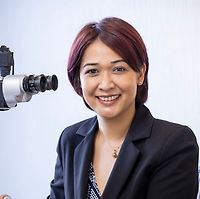Central Auckland > Public Hospital Services > Health New Zealand | Te Whatu Ora - Te Toka Tumai Auckland >
Ophthalmology Services | Auckland | Te Toka Tumai
Public Service, Ophthalmology
Today
Description
Optometrists are university trained professionals who diagnose eye disease, assess visual function, and prescribe spectacles and contact lenses as appropriate. Optometrists with TPA (therapeutic) endorsement may also prescribe a range of topical medicines (drops and ointment) for use in the eye.
Nurse Practitioners are university trained, advanced registered nurses who have met the NZ Nursing Council requirements and competencies to be formally registered as Nurse Practitioners in NZ. We currently have three Nurse Practitioners in the ADHB Ophthalmology department who also provide comprehensive assessment, management and prevention of eye disease, perform various assessments and procedures and can prescribe required medications. Our Nurse Practitioners have their own independent clinics and also work alongside our ophthalmologists in various areas of the department. For more information on Nurse Practitioners in NZ visit the NZNC website: http://www.nursingcouncil.org.nz/Nurses/Scopes-of-practice/Nurse-practitioner
Nurse Specialists are university trained registered nurses in advanced nursing practice roles and are responsible for providing specialist nursing care and/or coordination of care to a specific patient / client population across health care settings. We currently have six Nurse Specialists in the ADHB Ophthalmology department who provide comprehensive assessment and management of eye disease and have met NZ Nursing Council requirements to work in Expanded Practice roles to perform various assessments and procedures within the department. For more information visit tthe NZNC website: http://www.nursingcouncil.org.nz/Nurses/Scopes-of-practice/Registered-nurse
Orthoptists are experts in the assessment, diagnosis and treatment of squints (see below), amblyopia and eye movement problems. Most of their patients are children as squints and amblyopia usually need treatment during early childhood. Adults may also need assessment as squints and eye movement problems may develop at a later age and this may result in double vision or other symptoms which can be monitored and managed by the Orthoptist. Orthoptics: Ortho = straight; Optics = eyes.
Low Vision Clinic is part of the Eye Department at Greenlane Clinical Centre. If you are experiencing difficulties in daily living activities such as meal preparation, using the telephone or identifying money to name a few, and have already been seen by an optometrist or ophthalmologist, the clinic may be able to assist you to make the best use of your remaining vision.
You will be seen by a Low Vision Therapist who can advise you about lighting, colour contrast, adaptive aids and strategies to assist you to safely maintain your independence. You will also be seen by a Low Vision Optometrist who may prescribe a Low Vision aid to assist with reading and other near tasks or with distance vision.
Your GP, optometrist, ophthalmologist, Eye Clinic nurse or Blind Foundation staff can refer you to the clinic by using our referral form or by sending a letter including information about your eye condition, visual acuity, treatment and the reason for the referral. As this is a public hospital clinic there is no charge for NZ residents but you have the option of purchasing items demonstrated at the clinic.
See the attached flyer below for some basic information on Understanding the Needs of People with Sight Loss.
Staff
Optometrists are university trained professionals who diagnose eye disease, assess visual function, and prescribe spectacles and contact lenses as appropriate. Optometrists with TPA (therapeutic) endorsement may also prescribe a range of topical medicines (drops and ointment) for use in the eye.
Nurse Practitioners are university trained, advanced registered nurses who have met the NZ Nursing Council requirements and competencies to be formally registered as Nurse Practitioners in NZ. We currently have three Nurse Practitioners in the ADHB Ophthalmology department who also provide comprehensive assessment, management and prevention of eye disease, perform various assessments and procedures and can prescribe required medications. Our Nurse Practitioners have their own independent clinics and also work alongside our ophthalmologists in various areas of the department. For more information on Nurse Practitioners in NZ visit the NZNC website: http://www.nursingcouncil.org.nz/Nurses/Scopes-of-practice/Nurse-practitioner
Nurse Specialists are university trained registered nurses in advanced nursing practice roles and are responsible for providing specialist nursing care and/or coordination of care to a specific patient / client population across health care settings. We currently have six Nurse Specialists in the ADHB Ophthalmology department who provide comprehensive assessment and management of eye disease and have met NZ Nursing Council requirements to work in Expanded Practice roles to perform various assessments and procedures within the department. For more information visit the NZNC website: http://www.nursingcouncil.org.nz/Nurses/Scopes-of-practice/Registered-nurse
Orthoptists are experts in the assessment, diagnosis and treatment of squints (see below), amblyopia and eye movement problems. Most of their patients are children as squints and amblyopia usually need treatment during early childhood. Adults may also need assessment as squints and eye movement problems may develop at a later age and this may result in double vision or other symptoms which can be monitored and managed by the Orthoptist. Orthoptics: Ortho = straight; Optics = eyes.
Low Vision Clinic is part of the Eye Department at Greenlane Clinical Centre. If you are experiencing difficulties in daily living activities such as meal preparation, using the telephone or identifying money to name a few, and have already been seen by an optometrist or ophthalmologist, the clinic may be able to assist you to make the best use of your remaining vision.
You will be seen by a Low Vision Therapist who can advise you about lighting, colour contrast, adaptive aids and strategies to assist you to safely maintain your independence. You will also be seen by a Low Vision Optometrist who may prescribe a Low Vision aid to assist with reading and other near tasks or with distance vision.
Your GP, optometrist, ophthalmologist, Eye Clinic nurse or Blind Foundation staff can refer you to the clinic by using our referral form or by sending a letter including information about your eye condition, visual acuity, treatment and the reason for the referral. As this is a public hospital clinic there is no charge for NZ residents but you have the option of purchasing items demonstrated at the clinic.
See the attached flyer below for some basic information on Understanding the Needs of People with Sight Loss.
Consultants
-

Dr Nadeem Ahmad
Ophthalmologist
-

Dr Rachel Barnes
Ophthalmologist
-

Dr Sonya Bennett
Ophthalmologist
-

Dr Stephen Best
Ophthalmologist
-

Dr Riyaz Bhikoo
Ophthalmologist
-

Dr Stuart Carroll
Ophthalmologist
-

Dr Shenton Chew
Ophthalmologist
-

Dr Cheefoong Chong
Ophthalmologist
-

Dr Chi-Ying Chou
Ophthalmologist
-

Dr Dean Conger
Ophthalmologist
-

Dr Alexandra Crawford
Ophthalmologist
-

Dr William Cunningham
Ophthalmologist
-

Prof Helen Danesh-Meyer
Ophthalmologist
-

Dr Clairton de Souza
Ophthalmologist
-

Dr Narme Deva
Ophthalmologist
-

Dr Mark Donaldson
Ophthalmologist
-

Dr Julia Escardo-Paton
Ophthalmologist
-

Dr Yi Wei Goh
Ophthalmologist
-

Dr Arvind Gupta
Ophthalmologist
-

Dr Peter Hadden
Ophthalmologist
-

Dr Richard Hart
Ophthalmologist
-

Dr Sophie Hill
Ophthalmologist
-

Dr Sarah Hull
Ophthalmologist
-

Dr Tahira Malik
Ophthalmologist
-

Dr Kaliopy Matheos
Ophthalmologist
-

Prof Charles McGhee
Ophthalmologist
-

Dr Catherine McMurray
Ophthalmologist
-

Dr Jay Meyer
Ophthalmologist
-

Dr Justin Mora
Ophthalmologist
-

Dr Rachael Niederer
Ophthalmologist
-

Dr Siddharth Ogra
Ophthalmologist
-

Dr Susan Ormonde
Ophthalmologist
-

Dr Taras Papchenko
Ophthalmologist
-

Dr Hussain Patel
Ophthalmologist
-

Dr David Pendergrast
Ophthalmologist
-

Dr Divya Perumal
Ophthalmologist
-

Dr Monika Pradhan
Ophthalmologist
-

Dr Andrew Riley
Ophthalmologist
-

Dr Paul Rosser
Ophthalmologist
-

Dr Leo Sheck
Ophthalmologist
-

Dr Jo Sims
Ophthalmologist
-

Dr Brian Sloan
Ophthalmologist
-

Ophthalmologist
-

Dr Kathleeya Stang-Veldhouse
Ophthalmologist
-

Dr Shanu Subbiah
Ophthalmologist
-

A/Prof Andrea Vincent
Ophthalmologist
-

Dr Sarah Welch
Ophthalmologist
-

Dr Aaron Wong
Ophthalmologist
-

Dr Joel Yap
Ophthalmologist
-

Dr Mo Ziaei
Ophthalmologist
Referral Expectations
To be seen at the outpatient clinic by one of our specialist clinicians, you will need a letter of referral to be sent to the hospital by your GP or by your optometrist.
Fees and Charges Description
Currently New Zealand residents pay for their public health service through their taxes and there are no additional charges to them at the hospital. Non-New Zealand residents are responsible for the full cost of any medical or surgical treatment they receive at Auckland City Hospital or Greenlane Clinical Centre.
Hours
| Mon – Fri | 8:00 AM – 5:00 PM |
|---|
Please see below for where to find us, and more information about our weekend and evening clinics.
After hours/in case of emergency
If you need urgent care– you can visit an after-hours GP or optometrist, or visit your nearest Accident and Medical (A&M) clinic. You can find a list of Accident and Medical clinics across the Auckland region, including their opening times, here.
You can also contact Healthline on 0800 611 116 for free advice.
For further information/options please go to http://www.adhb.health.nz/your-health/the-right-care-for-you/
If it’s an emergency, don’t hesitate - call 111 or go to your nearest hospital emergency department.
Please note we DO NOT have a "walk-in" clinic. All patients must be referred by their GP, Optometrist or Emergency/Accident & Medical Clinic unless otherwise advised by Ophthalmology department staff.
EYE CLINIC: GROUND FLOOR, BUILDING 8, GREENLANE CLINICAL CENTRE. Enter the Greenlane Clinical Centre through the main entrance at Building 4 (by the Pharmacy and Jamaica Blue) and walk through, past Planet Espresso to Building 8. Reception M is on the left. General Ophthalmology (Eye) clinics are open Monday to Friday 8am - 5pm. We also run weekend and evening clinics, please refer to your appointment letter for more details.
If you are booked in for a weekend or evening clinic (weekdays after 5PM) please note:
- There is only one entrance to get to your weekend and evening Eye Clinic appointment. Please use the main entrance into building 4.
TOTARA WARD (Eye Ward) LEVEL 2, BUILDING 4, GREENLANE CLINICAL CENTRE The Totara Ward is located on Level 2, Building 4. Use lift bank A to level 2 and report to the main reception desk.
ACUTE EYE SERVICE: Please note we DO NOT have a "walk-in" clinic. You need to be referred by your GP, optometrist, local Emergency/Accident & Medical Clinic or have been advised to contact us directly if you have already been seen in our department. If you are seen by a GP/doctor or optometrist in the community or hospital, they can call us directly to discuss your condition. If you need urgent assessment an appointment will be made for you in the Acute Eye Service during normal business hours. If there are no appointments available, or your condition needs to be seen more urgently, you will be advised to attend the Emergency Eye Clinic with your referral. Please keep in mind that due to the large number of patients attending our acute service, there is often a very long wait (up to 6-8 hours) to be seen by a Doctor, Clinical Nurse Specialist, Nurse Practitioner or Optometrist depending on how urgent your condition is. The Emergency Eye Clinic is located in the Eye Clinic Monday to Friday 8am - 5pm, and Saturday 8am - 3pm. We have a reduced after hours service until 7pm, however no follow-up patients will be seen during this time. On Sundays the Emergency Eye Clinic is run from the Totara Ward as a reduced service 8am - 7pm. From 7pm until 8am every night all eye emergencies should please report to Auckland City Hospital Emergency Department, your local Hospital Emergency Department or your local emergency/A&M clinic. Please see the attached "Acute Eye Service" flyer below for further information.
WAITAKERE OUTPATIENT CLINIC: We also provide outpatient clinics for certain sub-specialties/conditions at the outpatient department at Waitakere Hospital, Monday - Friday 8am-5pm only. NO ACUTE SERVICE PROVIDED AT THIS LOCATION.
OTHER LOCATIONS: We also provide clinics and surgical services at various locations in the Auckland region. You will be contacted with this information or please check your appointment letter for more details.
Common Conditions
These conditions cause distance blur. In myopia, the eye has a resting focus at a near distance so that people will be able to see objects clearly at some point close to them, whilst the distance is blurry. Hyperopia also causes distance blur but often does not become noticeable until the eye loses its ability to change focus, frequently in middle age. The loss of focus for near distance (presbyopia or “aged sight”) is also related to a decreased ability to change focus but only affects reading. Astigmatism causes an image to be blurry at all distances, but does not affect clarity of images unless it is severe. An optometrist or ophthalmologist can test for these conditions. Treatment is usually glasses or contact lenses which are only obtainable through an optometrist or dispensing optician. Laser surgery and other corrective surgical techniques can also be used to change the focus of the eye to give clarity of sight in suitable patients. Laser refractive surgery is not currently available at Auckland City Hospital and is only available through private specialists.
These conditions cause distance blur. In myopia, the eye has a resting focus at a near distance so that people will be able to see objects clearly at some point close to them, whilst the distance is blurry. Hyperopia also causes distance blur but often does not become noticeable until the eye loses its ability to change focus, frequently in middle age. The loss of focus for near distance (presbyopia or “aged sight”) is also related to a decreased ability to change focus but only affects reading. Astigmatism causes an image to be blurry at all distances, but does not affect clarity of images unless it is severe. An optometrist or ophthalmologist can test for these conditions. Treatment is usually glasses or contact lenses which are only obtainable through an optometrist or dispensing optician. Laser surgery and other corrective surgical techniques can also be used to change the focus of the eye to give clarity of sight in suitable patients. Laser refractive surgery is not currently available at Auckland City Hospital and is only available through private specialists.
These conditions cause distance blur. In myopia, the eye has a resting focus at a near distance so that people will be able to see objects clearly at some point close to them, whilst the distance is blurry.
Hyperopia also causes distance blur but often does not become noticeable until the eye loses its ability to change focus, frequently in middle age. The loss of focus for near distance (presbyopia or “aged sight”) is also related to a decreased ability to change focus but only affects reading.
Astigmatism causes an image to be blurry at all distances, but does not affect clarity of images unless it is severe.
An optometrist or ophthalmologist can test for these conditions. Treatment is usually glasses or contact lenses which are only obtainable through an optometrist or dispensing optician. Laser surgery and other corrective surgical techniques can also be used to change the focus of the eye to give clarity of sight in suitable patients. Laser refractive surgery is not currently available at Auckland City Hospital and is only available through private specialists.
Cataracts are the most common condition in eyes that comes on with age. The lens becomes thicker and stiffer and appears yellow and cloudy. Eventually it may turn white, changing the colour of the pupil. A cataract may cause your vision to become fuzzy slowly over time and may also be the cause of disabling glare. Once a cataract affects vision too much, you will need an operation to remove the lens. This decision is usually made in consultation with an eye specialist. The operation is almost always done under local anaesthetic. Once the cataract has been removed an artificial lens is put in to replace it. The operation is relatively short in duration and an overnight stay in hospital is not required. Post-operative care consists of eye drops and a check at 1-2 days then after 2-4 weeks. It is preferable for you to be assessed by an optometrist who can provide detailed referral information about your eye health and if you meet criteria for publicly funded surgery you may be able to be booked directly for surgery.
Cataracts are the most common condition in eyes that comes on with age. The lens becomes thicker and stiffer and appears yellow and cloudy. Eventually it may turn white, changing the colour of the pupil. A cataract may cause your vision to become fuzzy slowly over time and may also be the cause of disabling glare. Once a cataract affects vision too much, you will need an operation to remove the lens. This decision is usually made in consultation with an eye specialist. The operation is almost always done under local anaesthetic. Once the cataract has been removed an artificial lens is put in to replace it. The operation is relatively short in duration and an overnight stay in hospital is not required. Post-operative care consists of eye drops and a check at 1-2 days then after 2-4 weeks. It is preferable for you to be assessed by an optometrist who can provide detailed referral information about your eye health and if you meet criteria for publicly funded surgery you may be able to be booked directly for surgery.
Squints happen when one eye stops working with the other eye, usually causing the eye to turn inward or outward (less commonly upward or downward). Types of squint include: Esotropia/Convergent squint - one eye turns inwards towards the nose. Exotropia/Divergent squint - one eye turns outwards, away from the nose. Constant squint - one eye turns in all the time. Intermittent squint - one eye turns only some of the time. What causes squints? The following are possible causes: Long or short sight that is not corrected. The strain as your child tries to see clearly, may cause a squint Eye muscles that do not work properly (less common) In many cases there is no known cause. However, there may be a family history of squints. It is important to diagnose and treat a squint because if left untreated it may result in a permanent impairment of vision. How are squints treated? There are different types of squints and therefore different treatments. Each patient is assessed and treatment is advised on an individual basis. Children very rarely grow out of squints but the squint can change with age. The treatment for squints may include: Glasses: many childhood squints are connected with uncorrected long, or more rarely short, sight. Your child may need to wear glasses to see clearly. Glasses may sometimes help reduce the size of the squint. Patching: may be needed during childhood to improve the vision in the squinting eye. Patching does not cure the squint. Exercises: may help to control some types of squints. Prisms: may help to control some types of squint and can help patients with double vision. Surgery: may be required. If your Ophthalmologist/Orthoptist thinks this will help your child then they will discuss this with you. Some patients require a combination of these treatments.
Squints happen when one eye stops working with the other eye, usually causing the eye to turn inward or outward (less commonly upward or downward). Types of squint include: Esotropia/Convergent squint - one eye turns inwards towards the nose. Exotropia/Divergent squint - one eye turns outwards, away from the nose. Constant squint - one eye turns in all the time. Intermittent squint - one eye turns only some of the time. What causes squints? The following are possible causes: Long or short sight that is not corrected. The strain as your child tries to see clearly, may cause a squint Eye muscles that do not work properly (less common) In many cases there is no known cause. However, there may be a family history of squints. It is important to diagnose and treat a squint because if left untreated it may result in a permanent impairment of vision. How are squints treated? There are different types of squints and therefore different treatments. Each patient is assessed and treatment is advised on an individual basis. Children very rarely grow out of squints but the squint can change with age. The treatment for squints may include: Glasses: many childhood squints are connected with uncorrected long, or more rarely short, sight. Your child may need to wear glasses to see clearly. Glasses may sometimes help reduce the size of the squint. Patching: may be needed during childhood to improve the vision in the squinting eye. Patching does not cure the squint. Exercises: may help to control some types of squints. Prisms: may help to control some types of squint and can help patients with double vision. Surgery: may be required. If your Ophthalmologist/Orthoptist thinks this will help your child then they will discuss this with you. Some patients require a combination of these treatments.
Squints happen when one eye stops working with the other eye, usually causing the eye to turn inward or outward (less commonly upward or downward).
Types of squint include:
- Esotropia/Convergent squint - one eye turns inwards towards the nose.
- Exotropia/Divergent squint - one eye turns outwards, away from the nose.
- Constant squint - one eye turns in all the time.
- Intermittent squint - one eye turns only some of the time.
What causes squints?
The following are possible causes:
- Long or short sight that is not corrected. The strain as your child tries to see clearly, may cause a squint
- Eye muscles that do not work properly (less common)
- In many cases there is no known cause. However, there may be a family history of squints.
It is important to diagnose and treat a squint because if left untreated it may result in a permanent impairment of vision.
How are squints treated?
There are different types of squints and therefore different treatments. Each patient is assessed and treatment is advised on an individual basis. Children very rarely grow out of squints but the squint can change with age.
The treatment for squints may include:
- Glasses: many childhood squints are connected with uncorrected long, or more rarely short, sight. Your child may need to wear glasses to see clearly. Glasses may sometimes help reduce the size of the squint.
- Patching: may be needed during childhood to improve the vision in the squinting eye. Patching does not cure the squint.
- Exercises: may help to control some types of squints.
- Prisms: may help to control some types of squint and can help patients with double vision.
- Surgery: may be required. If your Ophthalmologist/Orthoptist thinks this will help your child then they will discuss this with you.
Some patients require a combination of these treatments.
Glaucoma is a group of diseases that can damage the eye’s optic nerve and may result in vision loss and blindness. Multiple factors are often important in causing glaucoma, but it is most commonly related to in an increase in pressure in the eye. The chronic form of glaucoma is known as the silent thief of vision as symptoms are generally absent until the condition has progressed to an advanced stage. Very occasionally, a rarer form of glaucoma can develop suddenly and symptoms may then include: headaches and aches around the affected eye, seeing halos around lights, sensitivity to light, blurred vision, nausea and vomiting. You may be more likely to develop glaucoma if you: have someone else in your family with glaucoma already have high pressure in your eye have experienced injury to your eye have had other eye conditions that can cause the eye pressure to rise have migraine or circulation problems. Glaucoma is more common in people over 50 years of age and more common in women than men. Diagnosis usually comes after consultation with an eye doctor. Signs of glaucoma may also be picked up at an optometrist’s eye examination. The following tests are used to diagnose and monitor glaucoma: Visual acuity test – test to check distance vision using an eye chart. Tonometry – measures eye pressure. It is often the first screening test for glaucoma. The eyes are numbed with eye drops and then examined. Dilated eye exam – this is done using the slit lamp and a lens which allows the clinician to examine the back of the eye. The optic nerve in particular is examined for any signs of damage. Visual field test – test to measure side (peripheral) vision. Pachymetry – test to measure the thickness of the cornea. Many other new techniques are emerging to help identify the likelihood of glaucoma and help determine its rate of progression. Eye drops to decrease eye pressure are the most common early treatment. There are many different options of eye drops we can use and sometimes more than one medication is required. Surgery may be required, especially if medications are not taking adequate effect. One of the more common operations to control glaucoma is a trabeculectomy and is performed when other methods have failed to adequately control eye pressure. This is a medium length operation that makes a new opening for fluid to drain from the eye. Other options for treatment can also be use such as Laser trabeculoplasty, in which a surgeon uses a laser to help open the drainage channels and allow more fluid to drain from the eye. Usually after laser treatment eye drops will still be needed although it may reduce the number of drops required. Although glaucoma cannot be cured, early treatment can prevent further worsening of the condition and vision loss. Regular eye examinations will need to be continued life-long. Most people diagnosed with glaucoma will be on treatment for life. Without treatment the eye pressure will return to the pre-treatment levels and continued damage to the optic nerve can occur. If you are concerned about whether you have glaucoma or not you should see a community optometrist for an assessment. If necessary a referral can be made to the ophthalmology department. For more information go to: https://www.glaucoma.org.nz/
Glaucoma is a group of diseases that can damage the eye’s optic nerve and may result in vision loss and blindness. Multiple factors are often important in causing glaucoma, but it is most commonly related to in an increase in pressure in the eye. The chronic form of glaucoma is known as the silent thief of vision as symptoms are generally absent until the condition has progressed to an advanced stage. Very occasionally, a rarer form of glaucoma can develop suddenly and symptoms may then include: headaches and aches around the affected eye, seeing halos around lights, sensitivity to light, blurred vision, nausea and vomiting. You may be more likely to develop glaucoma if you: have someone else in your family with glaucoma already have high pressure in your eye have experienced injury to your eye have had other eye conditions that can cause the eye pressure to rise have migraine or circulation problems. Glaucoma is more common in people over 50 years of age and more common in women than men. Diagnosis usually comes after consultation with an eye doctor. Signs of glaucoma may also be picked up at an optometrist’s eye examination. The following tests are used to diagnose and monitor glaucoma: Visual acuity test – test to check distance vision using an eye chart. Tonometry – measures eye pressure. It is often the first screening test for glaucoma. The eyes are numbed with eye drops and then examined. Dilated eye exam – this is done using the slit lamp and a lens which allows the clinician to examine the back of the eye. The optic nerve in particular is examined for any signs of damage. Visual field test – test to measure side (peripheral) vision. Pachymetry – test to measure the thickness of the cornea. Many other new techniques are emerging to help identify the likelihood of glaucoma and help determine its rate of progression. Eye drops to decrease eye pressure are the most common early treatment. There are many different options of eye drops we can use and sometimes more than one medication is required. Surgery may be required, especially if medications are not taking adequate effect. One of the more common operations to control glaucoma is a trabeculectomy and is performed when other methods have failed to adequately control eye pressure. This is a medium length operation that makes a new opening for fluid to drain from the eye. Other options for treatment can also be use such as Laser trabeculoplasty, in which a surgeon uses a laser to help open the drainage channels and allow more fluid to drain from the eye. Usually after laser treatment eye drops will still be needed although it may reduce the number of drops required. Although glaucoma cannot be cured, early treatment can prevent further worsening of the condition and vision loss. Regular eye examinations will need to be continued life-long. Most people diagnosed with glaucoma will be on treatment for life. Without treatment the eye pressure will return to the pre-treatment levels and continued damage to the optic nerve can occur. If you are concerned about whether you have glaucoma or not you should see a community optometrist for an assessment. If necessary a referral can be made to the ophthalmology department. For more information go to: https://www.glaucoma.org.nz/
Glaucoma is a group of diseases that can damage the eye’s optic nerve and may result in vision loss and blindness. Multiple factors are often important in causing glaucoma, but it is most commonly related to in an increase in pressure in the eye. The chronic form of glaucoma is known as the silent thief of vision as symptoms are generally absent until the condition has progressed to an advanced stage.
Very occasionally, a rarer form of glaucoma can develop suddenly and symptoms may then include: headaches and aches around the affected eye, seeing halos around lights, sensitivity to light, blurred vision, nausea and vomiting.
You may be more likely to develop glaucoma if you:
- have someone else in your family with glaucoma
- already have high pressure in your eye
- have experienced injury to your eye
- have had other eye conditions that can cause the eye pressure to rise
- have migraine or circulation problems.
Glaucoma is more common in people over 50 years of age and more common in women than men. Diagnosis usually comes after consultation with an eye doctor. Signs of glaucoma may also be picked up at an optometrist’s eye examination.
The following tests are used to diagnose and monitor glaucoma:
- Visual acuity test – test to check distance vision using an eye chart.
- Tonometry – measures eye pressure. It is often the first screening test for glaucoma. The eyes are numbed with eye drops and then examined.
- Dilated eye exam – this is done using the slit lamp and a lens which allows the clinician to examine the back of the eye. The optic nerve in particular is examined for any signs of damage.
- Visual field test – test to measure side (peripheral) vision.
- Pachymetry – test to measure the thickness of the cornea.
Many other new techniques are emerging to help identify the likelihood of glaucoma and help determine its rate of progression.
Eye drops to decrease eye pressure are the most common early treatment. There are many different options of eye drops we can use and sometimes more than one medication is required.
Surgery may be required, especially if medications are not taking adequate effect.
One of the more common operations to control glaucoma is a trabeculectomy and is performed when other methods have failed to adequately control eye pressure. This is a medium length operation that makes a new opening for fluid to drain from the eye.
Other options for treatment can also be use such as Laser trabeculoplasty, in which a surgeon uses a laser to help open the drainage channels and allow more fluid to drain from the eye. Usually after laser treatment eye drops will still be needed although it may reduce the number of drops required.
Although glaucoma cannot be cured, early treatment can prevent further worsening of the condition and vision loss. Regular eye examinations will need to be continued life-long.
Most people diagnosed with glaucoma will be on treatment for life. Without treatment the eye pressure will return to the pre-treatment levels and continued damage to the optic nerve can occur.
If you are concerned about whether you have glaucoma or not you should see a community optometrist for an assessment. If necessary a referral can be made to the ophthalmology department.
For more information go to: https://www.glaucoma.org.nz/
This is a complication of diabetes and is caused by small blood vessel damage within the retina of the eye. It commonly affects both eyes and may cause permanent loss of vision. Macular oedema is sometimes also present with diabetic retinopathy. Macular oedema is when fluid leaks into the retina and causes swelling and blurred vision. This may occur at any stage of diabetic retinopathy, but is more common as the disease progresses. There are often no symptoms in the early stages but as the condition progresses vision may begin to become impaired. Often visual loss may be sudden and without warning. This is why it is imperative that at-risk diabetics have frequent eye checks. Poorly controlled diabetes and pregnancy in diabetes are risk factors for developing this condition. Often, first-stage diabetic retinopathy requires no active treatment on the eye but requires stabilisation of diabetes and regular eye examinations. With progressive retinopathy, a laser treatment called the PRP laser can be used. This works by shrinking enlarged blood vessels to prevent further bleeding into the retina. Severe bleeding may require a surgical procedure called a vitrectomy, where blood is surgically removed from the eye. Treatment of macular oedema, if present, is by focal laser treatment. Vision is stabilised by reducing the degree of fluid leakage into the retina. Often more than one treatment is required.
This is a complication of diabetes and is caused by small blood vessel damage within the retina of the eye. It commonly affects both eyes and may cause permanent loss of vision. Macular oedema is sometimes also present with diabetic retinopathy. Macular oedema is when fluid leaks into the retina and causes swelling and blurred vision. This may occur at any stage of diabetic retinopathy, but is more common as the disease progresses. There are often no symptoms in the early stages but as the condition progresses vision may begin to become impaired. Often visual loss may be sudden and without warning. This is why it is imperative that at-risk diabetics have frequent eye checks. Poorly controlled diabetes and pregnancy in diabetes are risk factors for developing this condition. Often, first-stage diabetic retinopathy requires no active treatment on the eye but requires stabilisation of diabetes and regular eye examinations. With progressive retinopathy, a laser treatment called the PRP laser can be used. This works by shrinking enlarged blood vessels to prevent further bleeding into the retina. Severe bleeding may require a surgical procedure called a vitrectomy, where blood is surgically removed from the eye. Treatment of macular oedema, if present, is by focal laser treatment. Vision is stabilised by reducing the degree of fluid leakage into the retina. Often more than one treatment is required.
This is when the retina detaches, meaning it is lifted or separated from its normal position within the eye. An acute retinal detachment requires urgent assessment and appropriate treatment. Unless prompt and effective treatment is given, some forms of retinal detachment may lead to irreversible blindness. Signs and symptoms include: a sudden or gradual increase in floaters, deterioration in vision, cobwebs or specks with the visual field, light flashes in the eye or the appearance of curtains over the visual field. You are more likely to have a retinal detachment if you are very short-sighted or have had an injury or previous surgery to the eye. For minor detachments, a laser or freeze treatment (cryopexy) are used. Both therapies re-attach the retina. For major detachment, surgery will be necessary. A band is often put around the back of the eye to prevent further detachment. Surgical treatment is usually a vitrectomy, where the jelly (vitreous) is removed from the eye. This often involves a hospital stay. It can take several months post-surgery to see the final visual result. If you are experiencing any of these symptoms see your GP, optometrist or local Emergency/A&M Clinic and a referral will be made to our department if needed.
This is when the retina detaches, meaning it is lifted or separated from its normal position within the eye. An acute retinal detachment requires urgent assessment and appropriate treatment. Unless prompt and effective treatment is given, some forms of retinal detachment may lead to irreversible blindness. Signs and symptoms include: a sudden or gradual increase in floaters, deterioration in vision, cobwebs or specks with the visual field, light flashes in the eye or the appearance of curtains over the visual field. You are more likely to have a retinal detachment if you are very short-sighted or have had an injury or previous surgery to the eye. For minor detachments, a laser or freeze treatment (cryopexy) are used. Both therapies re-attach the retina. For major detachment, surgery will be necessary. A band is often put around the back of the eye to prevent further detachment. Surgical treatment is usually a vitrectomy, where the jelly (vitreous) is removed from the eye. This often involves a hospital stay. It can take several months post-surgery to see the final visual result. If you are experiencing any of these symptoms see your GP, optometrist or local Emergency/A&M Clinic and a referral will be made to our department if needed.
Contact lenses may be worn to correct vision, manage eye conditions or for cosmetic reasons (e.g. coloured contact lenses). Care should always be taken when wearing and cleaning all types of contact lenses to avoid problems/complications. Always follow the instructions given to you by your eye care professional. For more information go to: www.contactlens.org.nz
Contact lenses may be worn to correct vision, manage eye conditions or for cosmetic reasons (e.g. coloured contact lenses). Care should always be taken when wearing and cleaning all types of contact lenses to avoid problems/complications. Always follow the instructions given to you by your eye care professional. For more information go to: www.contactlens.org.nz
Contact lenses may be worn to correct vision, manage eye conditions or for cosmetic reasons (e.g. coloured contact lenses).
Care should always be taken when wearing and cleaning all types of contact lenses to avoid problems/complications. Always follow the instructions given to you by your eye care professional.
For more information go to: www.contactlens.org.nz
Please find attached the patient information pamphlet regarding intravitreal (eye) injections Information for Patients & Whanau After Intravitreal Injections.pdf.pdf.pdf.pdf (PDF, 110.3 KB)
Please find attached the patient information pamphlet regarding intravitreal (eye) injections Information for Patients & Whanau After Intravitreal Injections.pdf.pdf.pdf.pdf (PDF, 110.3 KB)
Please find attached the patient information pamphlet regarding intravitreal (eye) injections
https://www.nzta.govt.nz/resources/factsheets/25/
https://www.nzta.govt.nz/resources/factsheets/25/
https://www.nzta.govt.nz/resources/supporting-senior-drivers/
https://www.nzta.govt.nz/resources/supporting-senior-drivers/
Document Downloads
- Acute Eye Service- What to Expect.pdf.pdf (PDF, 102.1 KB)
- Understanding the Needs of People with Sight Loss.pdf.pdf (PDF, 145.7 KB)
-
Adenoviral Conjunctivitis.pdf.pdf
(PDF, 31.5 KB)
Patient Information and Advice
-
Vision and Driving Factsheet.pdf.pdf
(PDF, 53 KB)
-
Supporting Senior Drivers.pdf.pdf
(PDF, 1.4 MB)
https://www.nzta.govt.nz/resources/supporting-senior-drivers/
-
Supporting Senior Drivers - Te Reo Maori.pdf.pdf
(PDF, 1.4 MB)
https://www.nzta.govt.nz/resources/supporting-senior-drivers/
Website
Contact Details
Greenlane Clinical Centre
Central Auckland
Website
Phone 0800 774 898
Outpatient appointments and surgical bookings (09) 638 0400 or scheduling@adhb.govt.nz
GP/ External Specialist Help Desk (09) 307 2800
Mental Health Services 24 Hour Crisis helpline 0800 800171
Ground Floor, Building 8
Greenlane Clinical Centre
Greenlane Road
Greenlane
Auckland
Please note we DO NOT have a "walk-in" clinic. All patients must be referred by their GP or optometrist, unless advised otherwise by the Ophthalmology Department staff.
Kia ora.
COVID Update
• We are still seeing patients in person who require appointments. If you have an in person appointment and have any COVID-19 symptoms or have been told by public health to isolate please phone the number on your appointment letter in advance.
The situation is changing so please continue to visit the Auckland DHB website for updates.
Enter Greenlane Clinical Centre through the main entrance of Building 4 (by the Pharmacy and Jamaica Blue) and walk through, past Planet Espresso, to Building 8. Reception M is on the left.
Street Address
Ground Floor, Building 8
Greenlane Clinical Centre
Greenlane Road
Greenlane
Auckland
Please note we DO NOT have a "walk-in" clinic. All patients must be referred by their GP or optometrist, unless advised otherwise by the Ophthalmology Department staff.
Kia ora.
COVID Update
• We are still seeing patients in person who require appointments. If you have an in person appointment and have any COVID-19 symptoms or have been told by public health to isolate please phone the number on your appointment letter in advance.
The situation is changing so please continue to visit the Auckland DHB website for updates.
Enter Greenlane Clinical Centre through the main entrance of Building 4 (by the Pharmacy and Jamaica Blue) and walk through, past Planet Espresso, to Building 8. Reception M is on the left.
Postal Address
Private Bag 92 189
Auckland Mail Centre
Auckland 1142
Was this page helpful?
This page was last updated at 9:21AM on February 13, 2025. This information is reviewed and edited by Ophthalmology Services | Auckland | Te Toka Tumai.

